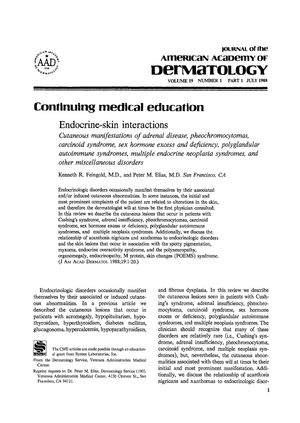Endocrine-Skin Interactions
July 1988
in “
Journal of The American Academy of Dermatology
”
Cushing's syndrome adrenal insufficiency pheochromocytomas carcinoid syndrome sex hormone imbalances polyglandular autoimmune syndromes multiple neoplasia syndromes ACTH MSH androgen excess hirsutism acne virilization precocious puberty partial 21-hydroxylase deficiency polycystic ovarian syndrome insulin resistance acanthosis nigricans hyperandrogenism xanthomas Cushing's adrenal insufficiency pheochromocytomas carcinoid syndrome sex hormone imbalances polyglandular autoimmune syndromes multiple neoplasia syndromes ACTH MSH androgen excess hirsutism acne virilization precocious puberty 21-hydroxylase deficiency PCOS insulin resistance acanthosis nigricans hyperandrogenism xanthomas

TLDR Hormone imbalances can cause specific skin changes, which may help in early detection of endocrine disorders.
The 1988 document reviews the relationship between endocrine disorders and skin manifestations. It covers conditions such as Cushing's syndrome, adrenal insufficiency, pheochromocytomas, carcinoid syndrome, sex hormone imbalances, polyglandular autoimmune syndromes, and multiple neoplasia syndromes, detailing their cutaneous symptoms. For example, Cushing's syndrome can lead to altered fat distribution, skin atrophy, and purple striae, while adrenal insufficiency often results in hyperpigmentation due to elevated ACTH and/or MSH levels. The document also discusses the effects of androgen excess, which can cause hirsutism, acne, and virilization in women, and precocious puberty in children. It highlights that partial 21-hydroxylase deficiency is a common cause of hirsutism, and that polycystic ovarian syndrome is a major cause of this condition. Additionally, the document notes that insulin resistance may be a common mechanism for acanthosis nigricans and hyperandrogenism, and that endocrine disorders can lead to lipid deposits in the skin known as xanthomas. The importance of dermatologists in early detection of endocrine disorders is emphasized, as skin changes can be the initial and most prominent signs of these conditions.


